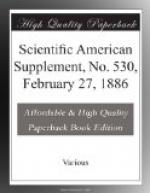At any point where it is desired to fix a pyrometer, a connection is made with the pipe last spoken of, by means of a small pipe such as is indicated at J, into which is fixed a platinum or other metallic nozzle of small bore, as shown at K. To this same pipe there is attached a solid-drawn copper spiral heater or worm, L, which is fixed into the place or the material the temperature of which it is desired to indicate. Into the outlet of this worm another similar but larger nozzle, M, is fixed. At N is shown a small pipe which is connected with the pipe, J, at any convenient point between the inlet nozzle, K, and the spiral heater, L. The other end of this pipe passes through the India rubber stopper of a small cistern or bottle, O, which, when in use, is about two-thirds filled with a colored liquid. It will be seen that the tube, N, only passes through the stopper, so that it may convey pressure to the surface of the liquid. At P is a glass tube which also passes through the stopper and then to the bottom of the colored liquid; and as its upper end is open, any variation of pressure in the spiral heater is directly transmitted to the indicating column of colored liquid.
[Illustration: FREW’S PYROMETER.]
The operation of the instrument is as follows: As the cold blast used in the apparatus would be useless for the working of the pyrometer if taken direct from the cold blast main, owing to its irregularity of pressure, the regulator that has been described is employed, and by its means an absolutely steady flow of cold blast air at an unvarying pressure is secured. The diameters of the inlet and outlet nozzles are so nicely adjusted that, so long as both are at the same temperature, the outlet nozzle, which is open to the atmosphere, will pass all the air that the inlet nozzle can deliver without disturbing the pressure in the cistern, O; but if heat be applied to the circulating air through the walls of the spiral heater, the air expands in volume, and is unable to pass through the outlet nozzle in its heated condition as rapidly as it is delivered cold by the inlet nozzle. The consequence is that an increase of pressure takes place in the apparatus between the two nozzles, and it is this pressure that indicates the amount of heat that the air has taken up from the hot blast pipe, in which the spiral heater is fixed. Then, again, as this pressure is directly transmitted to the indicating liquid in the cistern and the vertical tube immersed in it, a rise takes place in the column which is in exact proportion to the expansion of the current of blast passing through the spiral heater.




